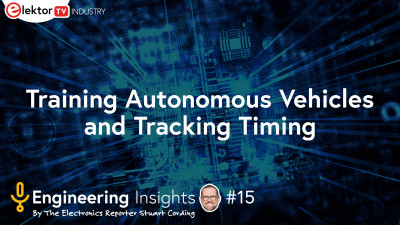Engineering Insights: Training Autonomous Vehicles, and the Best in Industry News!
January 30, 2023
on
on
Elektor has been busy exploring the world of automotive electronics, getting expert insights into how, and when, autonomous vehicles will come to fruition.
In Elektor's recent Engineering Insights episode, Giancarlo Cutrignelli of Eurotech explained the process and the hardware required. Test vehicles are used to gather real road conditions as seen by the array of sensors in use, with teams out on the highway for up to eight hours at a time. With up to 40 cameras and four to six radar, data is collected at a rate of around 40 Gbits/s, enough to fill 128 TB of storage in 12 hours. To support this, Eurotech offers a range of ruggedized high-performance edge computing (HPEC). With high-speed Ethernet interface, solid-state storage, and powerful CPU and GPU options, data is gathered reliably in the field and can be speedily transferred to lab-based teams.

Sometimes, deep learning algorithms are tested in the field too, a process known as inferencing. Trained algorithms run on the HPEC in real-time, analyzing the traffic situation and proposing relevant driving responses. This process is not in control of the vehicle; it merely serves to test the algorithm's ability to operate under realistic conditions.
Show host Stuart Cording also had a tablet oscilloscope to give to one lucky winner and announced that Sjon had won the Fortissimo-100 amplifier in the previous episode.
To catch up on the entire episode, jump over to Elektor TV - Industry or watch below:
This month, Stuart Cording looked at NXP's new SAF85 automotive radar. Matthias Feulner, Senior Director Marketing for Automotive Radar, explained the role of radar sensors in improving the protection of vulnerable road users (VRU). Thanks to design improvements of this RFCMOS, single-chip device, drivers receive an improved view of objects, such as a cyclist close to a lorry in the road ahead. The SAF85 is currently being used to develop radar sensors for next-generation vehicles.
There was also something new for software testers, with an update to SuperGuard from Solid Sands. With two-hundred additional tests, it is ideal for those maintaining C library implementations.
 With energy costs on the rise, Segger announced a software update to their range of J-Link debuggers. By making better use of LED dimming and clock frequency changes, power consumption can be reduced by half. This translates to around 5 Wh of savings at your development PC's power outlet. Spread across 100,000 debuggers, the saving is enough to power 50 German households.
With energy costs on the rise, Segger announced a software update to their range of J-Link debuggers. By making better use of LED dimming and clock frequency changes, power consumption can be reduced by half. This translates to around 5 Wh of savings at your development PC's power outlet. Spread across 100,000 debuggers, the saving is enough to power 50 German households.
To find out what else was covered, take a look at the show on Elektor TV — Industry, or directly here:

Tackling the Challenges of Training Autonomous Vehicles.
You've probably seen test cars driving around your town, filled to the brim with cameras, radar, lidar, and computing equipment. They're all part of the automotive industry's push to deliver the long-promised fleet of autonomous cars. But how are they contributing to the necessary deep-learning algorithms? And will the current way of developing automotive electronics fall by the wayside as a result?In Elektor's recent Engineering Insights episode, Giancarlo Cutrignelli of Eurotech explained the process and the hardware required. Test vehicles are used to gather real road conditions as seen by the array of sensors in use, with teams out on the highway for up to eight hours at a time. With up to 40 cameras and four to six radar, data is collected at a rate of around 40 Gbits/s, enough to fill 128 TB of storage in 12 hours. To support this, Eurotech offers a range of ruggedized high-performance edge computing (HPEC). With high-speed Ethernet interface, solid-state storage, and powerful CPU and GPU options, data is gathered reliably in the field and can be speedily transferred to lab-based teams.

Sometimes, deep learning algorithms are tested in the field too, a process known as inferencing. Trained algorithms run on the HPEC in real-time, analyzing the traffic situation and proposing relevant driving responses. This process is not in control of the vehicle; it merely serves to test the algorithm's ability to operate under realistic conditions.
Timing remains relevant
How the electronic and electrical (E/E) architecture is implemented will also need to change. Otherwise, the sensor data collection and necessary autonomous control will be challenging to implement. But, according to Peter Gliwa of Gliwa Embedded Systems, automotive development teams continue to struggle with timing issues. While software teams test to ensure features function correctly, sporadic issues often occur that are difficult to pin down. These are often traced to timing problems, and are typically related to the order in which code is executed and their relationship to other code and occurrences of interrupts. Peter's team support automotive manufacturers and their suppliers to find and resolve such issues. In his recently released book, he also combines his decades of experience with industry experts to help other avoid such challenges.Espressif for AIoT applications
The show's sponsor, Espressif, highlighted their range of AIoT SoCs, featuring Wi-Fi and Bluetooth 5 (LE). The ESP32-C3, based on the open-source RISC-V architecture, strikes the right balance of power, I/O capabilities, and security, thus offering the optimal cost-effective solution for connected devices. For powerful AI acceleration, developers should consider the ESP32-S3. With the same wireless features, it’s designed for AIoT applications thanks to its powerful AI acceleration and reliable security features. It also has added support for vector instructions in the MCU, speeding up neural network computing and signal processing workloads.Show host Stuart Cording also had a tablet oscilloscope to give to one lucky winner and announced that Sjon had won the Fortissimo-100 amplifier in the previous episode.
To catch up on the entire episode, jump over to Elektor TV - Industry or watch below:
Previously, on News Bytes
Engineers are always looking for new solutions to their problems, so for 2023, the Elektor team started a new show examining what's happening in the electronics and semiconductor industry. Going out on a Wednesday of each month, News Bytes explores upcoming trade fairs, new products, and how our industry impacts our world.This month, Stuart Cording looked at NXP's new SAF85 automotive radar. Matthias Feulner, Senior Director Marketing for Automotive Radar, explained the role of radar sensors in improving the protection of vulnerable road users (VRU). Thanks to design improvements of this RFCMOS, single-chip device, drivers receive an improved view of objects, such as a cyclist close to a lorry in the road ahead. The SAF85 is currently being used to develop radar sensors for next-generation vehicles.
Better SBC documentation
Building upon the popularity of single-board computers (SBC), OKdo announced a partnership with the RS Group. They're drawing upon the collective power of their 1.5 million-strong DesignSpark community to support their user base and improve their documentation.There was also something new for software testers, with an update to SuperGuard from Solid Sands. With two-hundred additional tests, it is ideal for those maintaining C library implementations.
 With energy costs on the rise, Segger announced a software update to their range of J-Link debuggers. By making better use of LED dimming and clock frequency changes, power consumption can be reduced by half. This translates to around 5 Wh of savings at your development PC's power outlet. Spread across 100,000 debuggers, the saving is enough to power 50 German households.
With energy costs on the rise, Segger announced a software update to their range of J-Link debuggers. By making better use of LED dimming and clock frequency changes, power consumption can be reduced by half. This translates to around 5 Wh of savings at your development PC's power outlet. Spread across 100,000 debuggers, the saving is enough to power 50 German households.
Decoding signals from space
Space exploration got exciting again with the launch of the Artemis One mission. The Bochum Observatory received support from Aaronia, who supplied them with a SPECTRAN V6 spectrum analyzer and their RTSA-Suite PRO analysis software. This will help decode the signals received during the mission via their 20 m parabolic antenna.To find out what else was covered, take a look at the show on Elektor TV — Industry, or directly here:

Hey - I have a great story...
Great! We'd love to hear it. Feel free to get in touch to learn how to share your news with us. Whether a product launch, new technology, breakthrough, or event, we'll try to squeeze it in somewhere. Simply get in touch with Stuart Cording via email, on Twitter, or LinkedIn.Read full article
Hide full article


Discussion (0 comments)